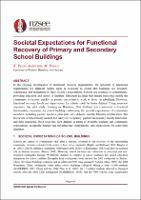| dc.description.abstract | In the ongoing investigation of functional recovery requirements, the spectrum of functional requirements for different facility types is necessary to ensure buildings are designed, constructed, and maintained to meet society's expectations. Schools are essential to communities, providing education and shelter to children. Education facilities that remain functional enable the community to recover quickly as parents can return to work or focus on rebuilding. However, functional recovery levels and expectations for schools could be better defined. Using interview responses, this pilot study, focusing on Hamilton, New Zealand, has constructed a five-level functionality continuum for school buildings addressing the societal expectations of community members, including parents, teachers, principals, civil defence, and the ministry of education. The five levels of functionality include life safety, reoccupancy, partial functionality, mostly functional, and fully functional. Each level has been defined in terms of available teaching and community expectations, acceptable damage and infrastructure requirements, and expectations for achievable timelines. | |

